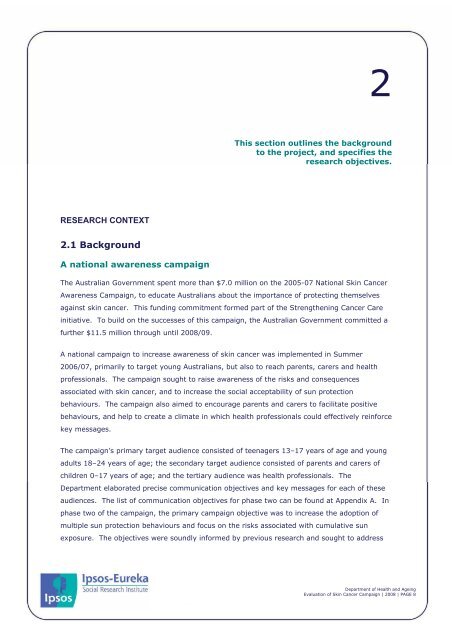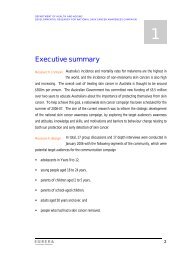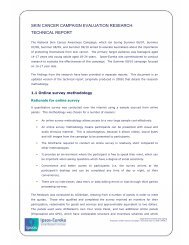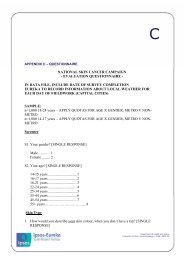2. Research context (PDF 74 KB) - National Skin Cancer Awareness ...
2. Research context (PDF 74 KB) - National Skin Cancer Awareness ...
2. Research context (PDF 74 KB) - National Skin Cancer Awareness ...
Create successful ePaper yourself
Turn your PDF publications into a flip-book with our unique Google optimized e-Paper software.
2<br />
This section outlines the background<br />
to the project, and specifies the<br />
research objectives.<br />
RESEARCH CONTEXT<br />
<strong>2.</strong>1 Background<br />
A national awareness campaign<br />
The Australian Government spent more than $7.0 million on the 2005-07 <strong>National</strong> <strong>Skin</strong> <strong>Cancer</strong><br />
<strong>Awareness</strong> Campaign, to educate Australians about the importance of protecting themselves<br />
against skin cancer. This funding commitment formed part of the Strengthening <strong>Cancer</strong> Care<br />
initiative. To build on the successes of this campaign, the Australian Government committed a<br />
further $11.5 million through until 2008/09.<br />
A national campaign to increase awareness of skin cancer was implemented in Summer<br />
2006/07, primarily to target young Australians, but also to reach parents, carers and health<br />
professionals. The campaign sought to raise awareness of the risks and consequences<br />
associated with skin cancer, and to increase the social acceptability of sun protection<br />
behaviours. The campaign also aimed to encourage parents and carers to facilitate positive<br />
behaviours, and help to create a climate in which health professionals could effectively reinforce<br />
key messages.<br />
The campaign’s primary target audience consisted of teenagers 13–17 years of age and young<br />
adults 18–24 years of age; the secondary target audience consisted of parents and carers of<br />
children 0–17 years of age; and the tertiary audience was health professionals. The<br />
Department elaborated precise communication objectives and key messages for each of these<br />
audiences. The list of communication objectives for phase two can be found at Appendix A. In<br />
phase two of the campaign, the primary campaign objective was to increase the adoption of<br />
multiple sun protection behaviours and focus on the risks associated with cumulative sun<br />
exposure. The objectives were soundly informed by previous research and sought to address<br />
[ Department of Health and Ageing<br />
Evaluation of <strong>Skin</strong> <strong>Cancer</strong> Campaign | 2008 | PAGE 8
key issues related to target audience behaviour, awareness, attitude and intention. A summary<br />
of the campaign objectives is illustrated in the following diagram.<br />
<strong>Awareness</strong><br />
to increase perceived susceptibility to, and perceived severity<br />
of, skin cancer<br />
to reduce misperceptions about sun exposure<br />
to increase awareness of multiple sun protection behaviours<br />
Attitudes<br />
to increase and reinforce positive attitudes and socially<br />
normative beliefs towards adoption/modelling of multiple sun<br />
protection behaviours<br />
to reduce positive attitudes toward deliberate tanning<br />
to increase perceived risk of cumulative exposure<br />
Intentions<br />
and<br />
behaviour<br />
to increase and reinforce intentions to adopt multiple sun<br />
protection behaviours (i.e. the five key SunSmart behaviours)<br />
to increase and reinforce these behaviours<br />
Initially, the campaign was launched by the Chief Medical Officer, Professor John Horvath on 19<br />
November 2006. The campaign message aimed to get young people protecting themselves<br />
from sun exposure in five ways by seeking shade, wearing protective clothing, putting on a<br />
broad-brimmed hat, wearing wrap around sunglasses and applying SPF 30+ sunscreen. The<br />
media buy commenced on 19 November 2006 and ran until mid-February 2007 with the<br />
following materials specifically targeting youth from 13-24 years of age and parents:<br />
<br />
30 second television and cinema commercial;<br />
Radio x 2;<br />
<br />
<br />
<br />
<br />
Print execution for youth (magazine);<br />
Print execution for parents (magazine);<br />
Internet; and<br />
Outdoor advertising - bus shelters and interiors<br />
The media buy also included NESB (radio) and Indigenous (press) advertising.<br />
The Summer 07/08 campaign was launched by Nicola Roxon MP, on Sunday 6 January 2008.<br />
The campaign continued to feature the same TVC. In addition to the MCG radio advertisement,<br />
and the ‘There is a lot more to removing skin cancer than removing a mole’ print<br />
[ Department of Health and Ageing<br />
Evaluation of <strong>Skin</strong> <strong>Cancer</strong> Campaign | 2008 | PAGE 9
advertisement, there were new executions for radio and print advertising. These new<br />
executions aimed to broaden the campaign messages to include information about the risks<br />
associated with cumulative exposure. Specifically, the 07/08 media buy included the following:<br />
<br />
<br />
<br />
<br />
<br />
<br />
30 second television and cinema commercial;<br />
Radio (‘MCG’ and ‘Stapler’);<br />
Print execution x 3 (‘There is a lot more to treating skin cancer than removing a mole’,<br />
‘Don’t let your time in the sun catch up with you’, two executions);<br />
Internet;<br />
Outdoor advertising - transit and street furniture, and<br />
Community service announcements, such as those featuring actors from Home and Away.<br />
The media buy also included NESB (radio) and Indigenous (press) advertising.<br />
A selection of stills from the campaign TVC, the print advertisements, and the scripts of the TV<br />
and radio advertisements, can be found at Appendix B.<br />
Media <strong>context</strong><br />
During both phases of the <strong>National</strong> <strong>Skin</strong> <strong>Cancer</strong> <strong>Awareness</strong> Campaign, there were other<br />
campaigns on air and various messages in the media regarding skin cancer and sun protection.<br />
These included:<br />
Summer 2006/07<br />
QLD Suncorp Metway Sun Protection Campaign Young Adults<br />
NSW Tattoo - <strong>Skin</strong> <strong>Cancer</strong> – it’s killer body art Teenagers<br />
WA Don’t Cook for Looks Teenagers<br />
[ Department of Health and Ageing<br />
Evaluation of <strong>Skin</strong> <strong>Cancer</strong> Campaign | 2008 | PAGE 10
Summer 2007/08<br />
WA Don’t Cook for Looks Teenagers<br />
WA Blokes Men 18-34 years<br />
NSW The Dark Side of Tanning Teenagers<br />
VIC<br />
Clare Oliver Community Service Announcement,<br />
Brochure & Poster campaign<br />
Young Adults/Solarium Users<br />
Advertising for certain brands of skin care/sun protection products also appeared across both<br />
summers. There was also some media attention on the issue of Vitamin D deficiency among<br />
Australians. In late 2007, there was increasing media attention on the issue of deliberate<br />
tanning, and the death of Claire Oliver (a young woman who developed melanoma) generated<br />
significant media coverage and discussion about solarium use and the associated skin cancer<br />
risk.<br />
The research program<br />
In January 2006, Eureka Strategic <strong>Research</strong> undertook qualitative research designed to inform<br />
the campaign’s development. Knowledge, attitudes, awareness and understanding of sun<br />
protection and early detection of skin cancer were explored among adolescents, young adults,<br />
parents, adults aged 50 years and over and people who had had a skin cancer removed. This<br />
was followed by four stages of concept testing and refinement of the proposed campaign<br />
materials.<br />
Eureka Strategic <strong>Research</strong> was commissioned to undertake quantitative research to evaluate<br />
the <strong>National</strong> <strong>Skin</strong> <strong>Cancer</strong> <strong>Awareness</strong> Campaign. Baseline research was used to obtain precampaign<br />
measures, and post-campaign research was undertaken in February 2007 to assess<br />
the effectiveness of the campaign by measuring changes in the target audiences’ attitudes,<br />
knowledge and behaviour in relation to skin cancer prevention.<br />
To evaluate the Summer 07/08 advertising, and to monitor the impact of the campaign over<br />
time, Ipsos-Eureka Social <strong>Research</strong> Institute was commissioned to conduct additional<br />
quantitative research in November 2007, prior to the second phase of the campaign, and in<br />
February 2008.<br />
[ Department of Health and Ageing<br />
Evaluation of <strong>Skin</strong> <strong>Cancer</strong> Campaign | 2008 | PAGE 11
<strong>2.</strong>2 <strong>Research</strong> objectives<br />
The overall aim of this research was to evaluate the effectiveness of the <strong>National</strong> <strong>Skin</strong> <strong>Cancer</strong><br />
<strong>Awareness</strong> Campaign.<br />
Specifically, the research assessed:<br />
<br />
<br />
<br />
<br />
Campaign awareness;<br />
Attitudes and knowledge regarding skin cancer;<br />
Prevention intentions; and<br />
Prevention behaviour.<br />
The research design used to address these issues is detailed in the following section.<br />
[ Department of Health and Ageing<br />
Evaluation of <strong>Skin</strong> <strong>Cancer</strong> Campaign | 2008 | PAGE 12





